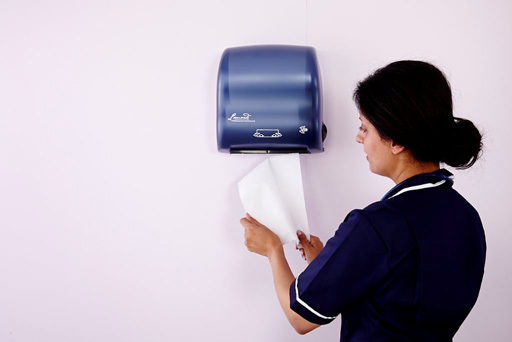

|
Chris Shaw
Editor |
Improve hand hygiene in hospitals
30 June 2015
Are hospitals making visitors aware that hygiene procedures apply to them? Of course they are, but perhaps there is still more to be achieved, explains Jonathan Hooper, marketing manager, Northwood Hygiene Products

Often the provision of alcohol based handrub dispensers are seen situated outside wards and others are strategically placed along corridors together with a sign explaining when and why the use of this provision is an essential step forward in reducing the incidence of cross infection within the hospital or health care facility.
However, the NHS organisations should aim to continually improve their approach to preventing infection (for example, by sharing information with other organisations and monitoring rates of infection). So says the National Institute for Health & Care Excellence (NICE) who point out that one in sixteen NHS patients picks up a hospital acquired infection such as MRSA. NICE has highlighted how basic hygiene protocols, such as hand washing may be overlooked by some health professionals. Professor Gillian Leng, director of Health and Social Care at NICE, is quoted as saying "Infections are a costly and avoidable burden that hinder a patients recovery."
All health care staff should always clean their hands thoroughly, both immediately before and immediately after coming into contact with a patient or carrying out care, and even after wearing gloves. Hands can usually be cleaned with either soap and water or an alcohol-based handrub; but soap and water must be used when the hands are obviously soiled or contaminated with bodily fluids, or when caring for people with diarrhoea or vomiting. All care providers should be trained in effective hand cleaning techniques. Hand hygiene in hospitals has improved in recent years says NICE, but good practice is still not universal.
Kingston Hospital has an Infection Prevention and Control Team who carry out ad hoc hand hygiene training on the wards using a light box to demonstrate the levels of hand contamination. This is a positive method of raising awareness of the issue.
If this is a problem amongst health care professionals, it is unsurprising that worried and concerned visitors to hospitals may need reminding of the role they can play in helping keep cross infection to a minimal level.
What hygiene procedures should visitors to hospitals follow?
NICE says when visiting someone in hospital, always clean hands using soap and water or alcohol handrubs. Do this when entering or leaving a patient’s room or other areas of the hospital. Effective hand decontamination relies on an effective technique, which includes:
• wetting hands with warm water
• applying an adequate amount of (preferably liquid) soap
• rubbing this thoroughly onto all hand surfaces (for at least 10 to 15 seconds)
• rinsing thoroughly
• drying thoroughly, preferably with disposable paper towel
• taps should be then turned off with the paper towel to avoid re-contaminating the hands
Alcohol handrub can only be used if hands are free from soiling. The handrub needs to be thoroughly rubbed into all hand surfaces until hands are completely dry.
All of which is sound advice, but setting up additional hand washing facilities is disruptive and costly at a time when NHS finances are under extreme pressure. This means that existing facilities are going to have even greater usage if these guidelines are to be followed. It’s then that the intrinsic values of dispensers such as Leonardo come to the fore.
Larger capacities means there is less chance of the hand towels running out at busy periods, single sheet presentation reduces the wastage, which means that the required number and frequency of maintenance inspections are lowered. The Compact range can be fitted when space is at a premium and for hygiene critical areas there are hands free dispensers in this range.
The recently announced initiative allowing visiting hours to be less restrictive and begin from late morning onwards, will no doubt further encourage visitors to come directly from their place of work to visit patients. This may mean that there will be even greater need to ensure the maximum opportunity for hand hygiene. Leonardo dispensing solutions are already found in hospitals and care homes across the UK and there is a wealth of experience in helping hospital managements deliver cost effective and successful hand hygiene regimes.
- Seven wipes for industry
- Reaching out for litter pickers
- Delivering washroom hygiene without costing the earth
- Effective hand drying is vital to limit the risk of a second spike
- On stand at H&S 2011 Scotland
- Do customers care about being green?
- Getting to the heart of the matter
- Cleaning Show victory for Northwood
- The Cinderella of hand hygiene?
- Washroom hygiene for the food sector
- No related articles listed





















